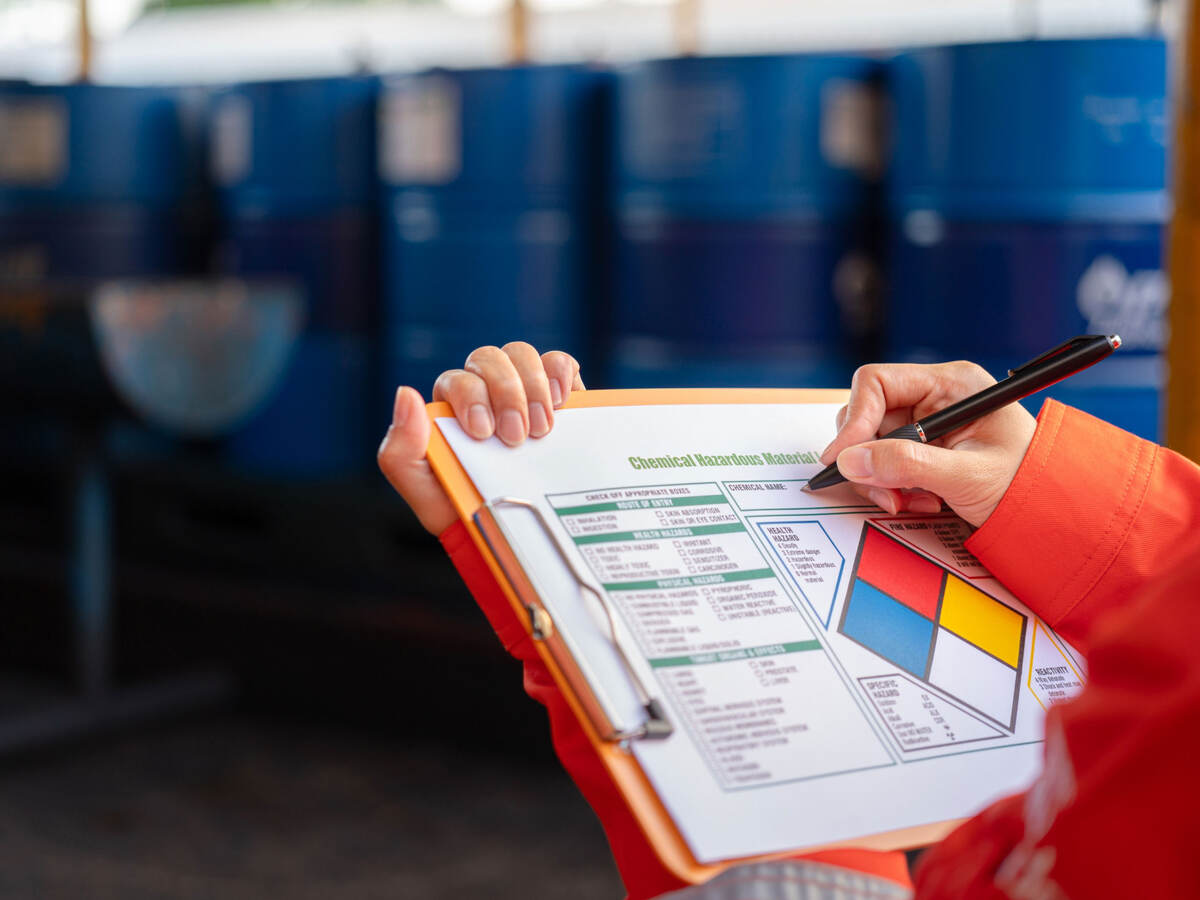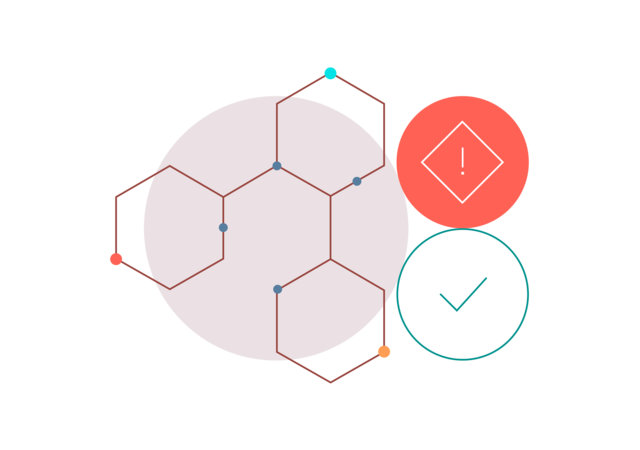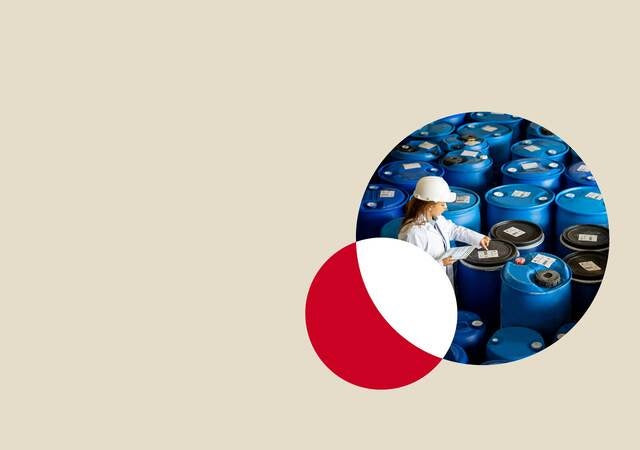Watch now: Navigating OSHA’s Hazcom update to align with GHS Revision 7
Get essential information on the latest changes in hazard communication from the regulatory experts at UL Solutions.
Webinar date
June 19, 2024
Speakers
Melissa Delaney, Senior Regulatory Affairs Manager
Alexis Wilhelm, Regulatory Affairs Lead
Joan McGuffey, Regulatory Affairs Lead
The U.S. Occupational Safety and Health Administration (OSHA) has announced their official update to the Hazard Communication Standard (HCS, 29 CFR 1910.1200) to align it with the seventh revised edition of the Globally Harmonized System of Classification and Labeling of Chemicals (GHS).
This webinar will help you gain a better understanding of specifics regarding what has changed in the HCS and how the new rules affect your hazcom program.
Learning objectives
Stay compliant
Gain insights to keep your workplace up-to-date with regulations.
Empower your team
Equip your team with knowledge to confidently navigate the HCS update to GHS Revision 7.
Get support
Engage with our regulatory experts and ask your questions.
Hazard Communication Standard (HCS) for alignment with GHS Revision 7 questions and answers
- Expand to view all questions and answers
Does the currently used compressed gas cylinder pictogram for aerosol air care products need to be removed with this update?
Yes, once the product is classified in accordance with HazCom 2024, the gases under pressure classification will no longer be appropriate for products classified as an aerosol. Review Appendix C for the appropriate labeling elements.
Will the US Department of Transportation (DOT) still recognize "combustible liquids" as a classification?
The update did not make any changes to the US DOT regulation. Currently, combustible liquid is still appropriate under US DOT.
Can you please elaborate on the differences between chemicals under pressure and aerosols?
The definition of chemicals under pressure is: Chemicals under pressure are liquids or solids (e.g., pastes or powders) pressurized with a gas at a pressure of 200 kPa (gauge) or more at 20°C in pressure receptacles other than aerosol dispensers and which are not classified as gases under pressure. Typically, chemicals under pressure would have a higher concentration of liquids or solids and a lower concentration of gas. In addition, chemicals under pressure are not in an aerosol dispenser.
For Appendix D Section 9, there was a change from "relative density" to "density and/or relative density." Should that be displayed as one line or two lines on the SDS?
The SDS is required to include all information listed in Table D.1 for Sections 1-11 and 16. However, there is no specific requirement regarding the layout or structure in which the information is presented.
How will major retail companies be affected by this change as they do not manufacture the products, but sell them?
The update did not alter any of the requirements for consumer products under the Consumer Product Safety Commission (CPSC). From a workplace management perspective, new product SDSs will be received to align with HazCom 2024 update. Employees will need some basic training to understand the new SDS requirements.
Does workplace information refer to just the written HazCom policy, or must companies obtain updated SDSs and labels used in on-site operations from suppliers by the relevant deadlines?
Workplace information includes the hazard communication program, part of the HazCom policy, and all alternative workplace labeling. In addition, employee training must be provided. OSHA has not yet provided guidance on whether employers will be seen as compliant with the new standard if they have requested updated SDSs from their suppliers, regardless of whether the updated SDSs have been supplied.
What advice do you have on aligning Section 3 formulation ranges with the US, Canada, and the requirements set by EU poison centre notification (PCN)?
There is no harmonization for component disclosure for the U.S., Canada and the EU. For OSHA compliance, all components that contribute to a health hazard must be listed in Section 3. A company can always communicate more components than the minimum requirements.
Can you comment on the difference between the U.S. interpretation of GHS versus Canada’s interpretation?
A few nuances still exist between the U.S. HazCom 2024 and Canada’s Hazardous Products Regulations (HPR).
- HNOC vs HHNOC/PHNOC labeling requirements
- Combustible dust classification and hazard statement
- Water reactive toxicants
- Biocidal products classification
These issues existed between HazCom 2012 and HPR 2015 and there still appears to be discrepancies between the Revision 7 and 8 updated regulations. Health Canada has published guidance to assist with the transition (https://www.canada.ca/en/health-canada/services/environmental-workplace-health/occupational-health-safety/workplace-hazardous-materials-information-system/supplier-hazard-communication-requirements-whmis/guidance.html). However, we do not have updated guidance or an inspection procedure from OSHA. We would expect that an updated inspection procedure would detail when including the Canadian requirements on a U.S. SDS or label would be a violation or not.
For U.S. home cleaning products, it is not required to include the H statements from the GHS classifications, pictograms or P statements from SDS Section 2 labeling elements. Do you foresee that the labeling of US home cleaning products will be updated coordinately with OSHA's adoption of GHS 7 and 8?
Consumer products continue to be regulated under the Consumer Product Safety Commission (CPSC). At this time, we are unaware of any timeline for CPSC to move to GHS classifications.
Will H400/401, H410/411/412 classifications be adopted in the U.S.?
No, OSHA did not adopt any of the environmental endpoints.
As to Section 14, will UN3082 be required to be added for a liquid mixture with long-term aquatic toxicity (H410 or H411)?
Section 14 remains a non-mandatory section, and the information included in the section is at the discretion of the SDS supplier. However, the OSHA update did not make any changes to the transportation requirements. If UN3082 is assigned, the UN number would still be valid.
The 90-day timeframe to update SDSs and the 6-month timeframe to update labels with new information is very different. Won't this cause the SDSs and labels to not match for a period of time?
The extended time provided to update labels aims to reduce the amount of relabeling that must occur. Because many companies will reauthor a SDS and then push the labeling information to an offsite or local printer at a facility, this extended transition period allows time for the updated labeling process to be completed.
Regarding release for shipment, does the statement "release for shipment" have to be printed on the GHS label with the date, or can it be printed on the label without the statement "release for shipment?" Can it be printed on the package itself?
The "release for shipment" date is not required to be printed on the label or package. The requirement to include the date on the label was in the draft, but it was not carried over in the final rule. Please see more discussion in the preamble.
Was the reproductive toxicity cut-off value changed from 0.1% to 0.01%?
No, we noticed this difference as well and reached out to OSHA for clarification. OSHA confirmed this was a typo, which will be corrected with a notice to the Federal Register. OSHA has now published the Regulatory Text on their website and Table A.7.1 has been corrected. However, there is still a typo in Table A.1.1 for the Dermal values, while Table A.1.2 is correct.
Do pictograms need to appear on product labels regardless of product sizes?
There are now two labeling exemptions for small containers. For <3 ml containers, only the product identifier must be listed on the label. These containers must be stored in the immediate outer package that contains the full OSHA label and a statement that requires the individual containers to be stored with the immediate outer package.
For <100 ml containers, all labeling elements are required except hazard and precautionary statements. This includes pictograms. An additional statement is required that the full OSHA label can be found on the immediate outer package, and the immediate outer package must then contain the full OSHA compliant label. Therefore, only <3 ml containers would not require pictograms. However, their full compliant OSHA label on the immediate outer package would.
Does the change to the categories criteria for flammable liquids no longer reflect the latest GHS criteria?
The flammable liquid criteria based on flash point and boiling point were fully aligned with the GHS with the adoption of HazCom 2012. The criteria have not changed with the HazCom 2024 update. OSHA has added notes, supporting text and updates to testing methods in alignment with GHS revision 7.
Is there any mandatory or recommended lifetime defined for SDSs?
No, SDSs should be accurate and updated when new information is received. SDSs must be updated within three months of becoming aware of updated information. For maintaining records, OSHA's record retention policy was not changed by the HazCom 2024 update.
Is it required to have transport information filled out for all of Section 14 at this time?
No, Section 14 remains a non-mandatory section, but the section number and header cannot be left blank. The specific information included in the header is up to the supplier. Appendix D Table D.1 information is only a recommendation for Sections 12 - 15 and are given to align with GHS.
Is it required to mention the creator of a SDS in section 16? Does it have to be an individual, or is a corporate email address sufficient?
Appendix D, Table D.1 states that the date of preparation of the SDS, or the last revision date, must be included in section 16. All other information would be optional. Best practice is to list a corporate email address that is monitored and accessible, rather than an individual's email address. If an individual's email address is used, but they leave the company or take on a new role, then all SDSs with their email address would need to be updated. Additionally, a corporate email address could be included in Section 1.
Does the 2024 HCS have any mention of Puerto Rico and other US territories?
The only reference to Puerto Rice is the OSHA-approved occupational safety and health plan that covers public and private-sector employees.
Explain the labeling requirements for Puerto Rico? English is required per the HCS, but the spoken language is Spanish. Would it be acceptable to use a Mexico label, in Spanish only, in Puerto Rico assuming that the hazard categories and concentration cut-offs align with both U.S. and Mexico standards?
Puerto Rico is one of the 22 states and territories with an OSHA-approved occupational safety and health plan that covers public and private sector employees. Mexico's GHS adoption does not align with OSHA. OSHA mandates that SDSs and labels must be available in English. Nevertheless, other languages, including Spanish for Puerto Rico, are allowed in addition to the English information. Best practice is to provide safety information in the language that is readily understood by the employees and workers.
When can I start updating SDSs and labels?
Suppliers are allowed to start updates now. SDSs and labels must be updated by the appropriate deadlines.
What are the due dates for updating the SDSs and labels for pure substances and mixtures for the US and Canada?
The U.S. adopted a phased-in approach. SDSs and labels for pure substances must be updated by January 19, 2026, and mixtures must be updated by July 19, 2027. Workplaces have a deadline six months after the substance and mixture deadlines.
Is the manufacturer recommended occupational exposure limit (OEL) optional in Section 8 of the SDS?
Mandatory OELs in Section 8 are OSHA permissible exposure limit (PEL) and the American Conference of Governmental Industrial Hygienists (ACGIH) Threshold Limit Value (TLV). Any other OEL can be included as well.
Will Hazards Not Otherwise Classified (HNOCs) now be required for labeling?
There are no mandatory labeling requirements for HNOCs. An exclamation point pictogram may be used with Hazards Not Otherwise Classified or HNOC below it, but C.2.3.4 states that a pictogram can only be used once.
We manufacture a solid plastic pellet. Currently, we do not include hazards associated with the powder physical state. Would we have to classify the pellet as a powder according to D.1 which requires classification for a change in the chemical's physical form? Or does this depend on expected or anticipated use of our compound?
OSHA added to the hazard statements for combustible dusts to inform users that the combustible dust concern exists only during further processing and not in its current form. OSHA has not noted any changes to the combustible dust classification requirement.
Does Section 3.0 still need to report only hazardous materials in a product or mixture?Appendix D lists the requirements for disclosure of components in a mixture. Components that are above the cut-off value and contribute to a health hazard must be listed in Section 3.
Is it necessary to find the inhalation LC50 for a liquid mixture that is 80% water?If a mixture LC50 value is not available, bridging principles can be applied. If bridging principles do not apply, classification for inhalation acute toxicity should be determined by using the appropriate additivity formula to calculate an Acute Toxicity Estimate (ATE) for your mixture. In Section A.1.3.6.1 it states that water and other substances that are presumed to be non-toxic can be ignored from the mathematical equation. It is important that water is not considered an unknown amount in the calculation. It would be important to investigate if the other 20% of the formula has any published LC50 values.
Did the cut-off concentrations in Section 3 change?Cut-off concentrations that drive disclosure in Section 3 did not change from HazCom 2012. It is important to remember that disclosure is driven when a substance presents a health hazard in the mixture. Each health hazard endpoint has its own specific requirements that need to be reviewed.
If we provide the SDS, which includes the GHS labeling elements in Section 2, will that address the electronic sharing of "released for shipment" requirement, or does it need to be a physical or electronic label copy specifically?In Section (f)(11), OSHA discusses the requirements for label updates. It specifically states that the updated label for each container must be provided. Based on this, it does not appear that providing the updated SDS only would be sufficient.
Is there going to be a grace period for blenders that have many raw materials that are mixtures?OSHA adopted a phased-in approach where pure substance SDSs must be updated by January 19, 2026, and mixtures by July 19, 2027. The 18-month period between the two deadlines should help mixture manufacturers to receive updated SDSs from their suppliers and update their SDSs where appropriate.
Are there examples you can share with labels and SDS changes?Due to the many different scenarios possible, it would be difficult to address all circumstances. We can provide consulting for specific products. Please use the contact us form to request our services.
Is it correct that only GHS labels are affected by the change, and consumer labels are not affected?Yes, that is correct.
When will WERCS Studio be updated with the new requirements for SDS authoring?All templates and work processes will be updated by the end of the year. Additional updates will be communicated through our monthly release notes.
Attend an upcoming webinar
Ready to elevate your industry IQ with insights and news from experts? Register for one of our upcoming events.
Get connected with our sales team
Thanks for your interest in our products and services. Let's collect some information so we can connect you with the right person.





